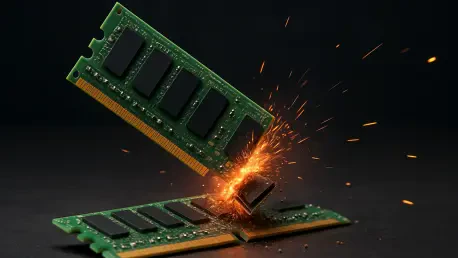What if the very technology safeguarding the world’s most sensitive data in the cloud could be undone by a gadget costing less than a night out? A startling discovery by researchers has unveiled a $50 hardware attack, dubbed “Battering RAM,” capable of piercing the defenses of Intel and AMD’s confidential computing systems. This isn’t a distant threat but a tangible exploit that challenges the bedrock of modern data security, raising alarms across industries reliant on cloud infrastructure.
The significance of this revelation cannot be overstated. Confidential computing, designed to protect critical information like financial transactions and personal identities from even the most insidious threats, is now under scrutiny. With data breaches costing companies millions annually—studies estimate an average loss of $4.45 million per incident in recent reports—the emergence of an affordable attack tool like Battering RAM could redefine risk in cloud environments. This story delves into how such a low-cost device operates, what experts are saying, and what can be done to shield against this unexpected vulnerability.
The Alarming Truth of a Low-Cost Security Breach
At the heart of this unsettling development lies Battering RAM, a hardware exploit crafted by researchers from KU Leuven and the University of Birmingham/Durham University. Using a custom-built device costing under $50, this attack targets the memory encryption of Intel SGX and AMD SEV-SNP technologies, which are pivotal in securing data within cloud systems. The affordability and accessibility of this tool starkly contrast with traditional attack hardware, often priced in the hundreds of thousands, making this a game-changer in cybersecurity risks.
The implications are profound, as this exploit doesn’t require sophisticated resources or deep technical expertise to execute. By leveraging open-source schematics available online, almost anyone with basic hardware knowledge could replicate this device. This democratization of attack capabilities sends a chilling message to organizations that have invested heavily in hardware-based security, prompting urgent questions about the adequacy of current protections.
The Growing Importance of Confidential Computing
Confidential computing has emerged as a cornerstone of data protection in an era where cyber threats loom larger than ever. With technologies like Intel SGX and AMD SEV-SNP, sensitive information remains encrypted even during processing in cloud environments, guarding against malicious insiders or compromised hosts. As cloud adoption skyrockets—reports indicate over 90% of enterprises now rely on cloud services—the need for such robust safeguards has never been more critical.
Yet, the rise of insider threats and supply chain vulnerabilities adds layers of complexity to this landscape. A single breach can erode customer trust and trigger regulatory penalties, with sectors like finance and healthcare facing particularly high stakes. The arrival of a budget-friendly attack like Battering RAM amplifies these concerns, exposing potential cracks in what many considered an impregnable shield.
How Battering RAM Works: Dissecting a $50 Threat
The mechanics of Battering RAM reveal a clever yet alarming approach to undermining memory encryption. Researchers developed an “interposer,” a small hardware device built for under $50 using readily available components and public schematics. Unlike commercial tools that carry exorbitant price tags, this affordable setup intercepts signals between the processor and memory, opening a backdoor to protected data.
By exploiting dynamic memory aliasing, the attack redirects encrypted data to locations controlled by the attacker, effectively bypassing defenses in Intel SGX and AMD SEV-SNP. A critical caveat is the need for one-time physical access to install the interposer, which limits its scope but still poses a significant risk in trusted settings like data centers or during hardware transit. Building on earlier exploits like BadRAM, this method evades boot-time security checks through runtime manipulations, showcasing the evolving ingenuity of hardware-based threats.
Expert Opinions and Industry Responses
Insights from the field paint a sobering picture of the security landscape. The researchers behind Battering RAM caution that “encrypted memory offers no defense against physical tampering,” urging a fundamental rethink of how threats are modeled. Their findings highlight a vulnerability that many in the industry had overlooked, pushing for broader awareness of hardware-level risks.
In contrast, responses from Intel and AMD reflect a more measured stance. Intel points to advanced encryption options like Total Memory Encryption-Multi-Key (TME-MK) as a potential mitigation, while acknowledging that physical attacks fall outside their primary security framework. AMD echoes this sentiment, referencing its documented threat model that excludes such exploits, revealing a notable disconnect between academic warnings and vendor priorities. This divergence underscores the challenge of aligning theoretical risks with practical industry strategies.
Protecting Against Hardware Threats: Steps Forward
Addressing the risks posed by Battering RAM demands actionable measures for organizations and cloud providers. Strengthening physical security protocols is paramount—implementing tighter access controls and continuous monitoring in data centers can deter unauthorized tampering by insiders or third parties. Such steps are essential to close the gap that physical access exploits.
Beyond this, verifying supply chain integrity through rigorous hardware checks during procurement and shipping can prevent interposer installations or other manipulations. Adopting advanced encryption modes, such as Intel’s TME-MK on supported processors, adds another layer of defense against alias-based attacks. Finally, advocating for updated threat models in collaboration with vendors ensures that physical threats are no longer sidelined, fostering a more comprehensive approach to security in an age where even a $50 device can disrupt years of innovation.
Reflecting on a Wake-Up Call
Looking back, the unveiling of Battering RAM served as a stark reminder that no technology is beyond the reach of determined adversaries. It exposed a critical blind spot in confidential computing, where physical vulnerabilities had been underestimated. The affordability and ingenuity of the attack left an indelible mark on how security is perceived, pushing for a reevaluation of long-held assumptions.
Moving forward, the path demands a blend of vigilance and innovation. Organizations need to prioritize physical security with the same rigor as digital defenses, while vendors must expand threat models to encompass emerging risks. Collaborative efforts between researchers, industry leaders, and policymakers promise to fortify cloud environments against such low-cost yet high-impact threats, ensuring that data protection evolves alongside the ever-changing landscape of cyber risks.









